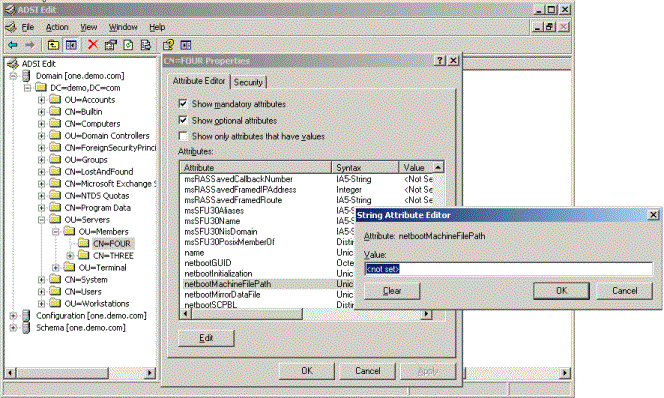How To Configure Wds Server 2008 R2 Step By Step
Automation
WDS Configuration
WDS interacts closely with DHCP, PXE, DNS and Active Directory. Every bit all of these functions are part of the Windows Server platform, it is cost-constructive to use them. DHCP tin also exist offered by a non-Windows server.
For more than information about Microsoft Windows Deployment Services, please refer to the Windows Deployment Services Getting Started Guide, available at http://technet.microsoft.com/en-us/library/cc771670(WS.10).aspx.
Active Directory configuration
- Configure WDS to reply just to "known" computers. To brand a new figurer known to WDS, it must be added to Active Directory.
- Configure the Active Directory attribute "netbootMachineFilePath" to determine the response of PXE to the request. This attribute can be edited with ADSI Edit. On servers running Microsoft Windows Server 2008 R2, ADSI Edit is installed when yous install the Active Directory Domain Services (Ad DS) role to make the server a domain controller. For more data almost ADSI Edit, see http://technet.microsoft.com/en-us/library/cc773354%28WS.10%29.aspx#BKMK_InstallingADSIEdit.

Some values that you can use are:
- \boot\x64\PXEBoot.com (requires users to press F12 for PXE boot)
- \boot\x64\PXEBoot.n12 (no user interaction required)
- \boot\x64\abortPXE.com (boots adjacent device, probably hard disk)
Use corresponding values for 32-bit computers.
WDS configuration
- Make sure DNS, Advertising and DHCP are working correctly (not necessarily on the same server).
- On the Start bill of fare, click Administrative Tools > Server Manager.
- Click Add Roles.
- Add Windows Deployment Services with Deployment Server and Transport Server as server roles.
- In the Server Managing director, expand the server list.
- Right-click the server that you lot want to manage, and click Configure Server. This starts the Windows Deployment Services Configuration Wizard.
DHCP option 60
If DHCP and PXE (part of WDS) are running on the same server, both processes must receive the DHCP request packet from the clients.
- Open the properties of the WDS server.
- On the DHCP tab, select Configure DHCP option sixty to point that this server is also a PXE Server. This redirects PXE requests to port 4011. Practice NOT select this option if PXE and DHCP are running on separate servers.
PXE server initial settings
- On the PXE Response tab, select either Reply only to known client computers or Reply to all client computers, depending on what you want to achieve. In a tightly managed surroundings, nosotros recommend to select Respond only to known client computers. Ivanti Automation will take care of the residual.
- Exercise NOT select Crave administrative approving.
Images
WDS makes utilise of images in 2 stages: a pre-boot Operating Organisation and an installed Operating System.
- Offset add a pre-boot Os. On the Start menu, click Administrative Tools > Server Manager > Windows Deployment Services.
- In the WDS administration tool, browse to the server that you are configuring, right-click the folder Kick Images and click Add Boot Image.
- Browse to the Sources binder on the Windows 2008R2 installation DVD and select kicking.wim. You can add together multiple boot Operating Systems for different platforms (x86 and x64).
- Afterward calculation the pre-kicking Os, add the Os that is intended to be installed on the target computers: in the WDS administration tool, browse to the server that yous are configuring, right-click the folder Install Images and click Add together Install Image.
- When prompted, browse to the Sources folder on the Windows 2008R2 installation DVD and select install.wim. Y'all tin can besides notice this file on the Windows 7 installation DVD.
- Yous may create different Image Groups for Workstation and Server Operating Systems. In this document nosotros presume 2 Image Groups: Workstations and Servers.
- Add the Ivanti Automation Agent manually to the Windows 7 or Windows 2008 epitome using the DISM command.
- Mount the image, add a c:\temp folder and copy the MSI file into this binder.
- Unmount the paradigm and do not forget to utilize the /commit choice.
Boot menu configuration
- In the WDS administration tool, correct-click the server that you lot are configuring and click Properties.
- Click the Boot tab.
- Select Ever proceed the PXE kick. This allows the boot procedure to be contained from user interaction. If y'all allow for user interaction (by pressing F12), the success of the boot procedure depends on the user reading the instructions on the screen and acting appropriately. Because this rarely happens, it is amend to bypass user interaction.
Boot loop
We assume the NIC to be the beginning in priority in the boot order. This can cause a boot loop: WDS deploys the image and the setup starts. During setup, the car reboots and everything starts from the beginning. To avoid this situation, WDS can modify the boot program during deployment if the post-obit registry central is set:
[HKEY_LOCAL_MACHINE\System\CurrentControlSet\services\WDSServer\Providers\WDSPXE\Providers\BINLSVC]
"ResetBootProgram"=dword:00000001
Unattend.xml
In the procedure, we need 2 unattend.txt files: 1 that is used in WinPE phase (WinPE.xml) and one that is associated with the epitome and is needed after WinPE phase (PostPE.xmfifty).
- Right-click the imported images and click Properties.
- Select Allow to install in unattended manner, select the "PostPE.xml" file and click OK.
- Get out the WinPE.xml in the WdsClientUnattend folder in the RemoteInstall install folder.
Source: https://help.ivanti.com/res/help/en_US/IA/2021/Admin/Content/21012.htm

0 Response to "How To Configure Wds Server 2008 R2 Step By Step"
Post a Comment